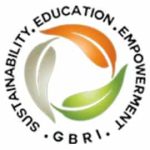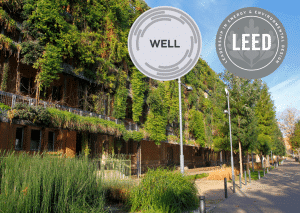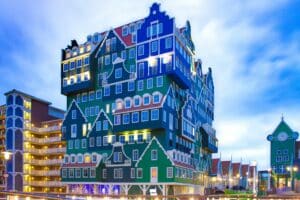New to LEED? Wondering if LEED is right for your project or you? Interested in becoming a LEED Green Associate or a LEED Professional? You have come to the right place. Here is everything you should know about the LEED v4 rating system as it relates to building certification and professional accreditation.
What is LEED and who is LEED for?
LEED or Leadership in Energy and Environmental Design is a green building rating system or certification program developed by the U.S. Green Building Council (USGBC). LEED applies to buildings and individuals. LEED certification is not for people but for buildings. Buildings get certified under LEED while professionals get accredited under LEED. LEED “certification” for buildings and LEED “accreditation” for people or individuals.
LEED address different building types ranging from homes to corporate office spaces. LEED v4 applies to buildings that are being newly constructed or going through a major renovation; includes New Construction, Core & Shell, Schools, Retail, Hospitality, Data Centers, Warehouses & Distribution Centers, and Healthcare. LEED v4, which is the newest LEED rating system address 21 building project types.
Starting from design, through construction, operation and maintenance of buildings – the objective of LEED certification revolves around incorporating sustainability throughout the lifecycle of a building. Projects pursuing LEED certification earn points across nine sustainability areas (listed below) that address sustainability issues such as energy efficiency, water efficiency, indoor environmental quality, materials and resources efficiency etc.
What are the benefits of LEED certification?
LEED-certified buildings are resource efficient. LEED-certified buildings use less water and energy and reduce greenhouse gas emissions.
Earning LEED certification contain benefits for design, construction and ownership of buildings. For owners, LEED promises several benefits. LEED buildings demonstrate higher tenant rates. Tenant are more likely to pay more for a LEED certified building. A building owner justifiably charges more for rent of a LEED building. Further increasing attractiveness for owners, LEED reduces Operating costs.
Tenants will pay more for the increase in health and productivity. In LEED, certified buildings, absenteeism fades dramatically. Productivity increases in a LEED certified building from improved air quality. Health, as measured by decrease in sick days, also increases productivity. 61% of companies cite sustainability as increasing financial stability. As more organizations acknowledge the positive influence of certifying LEED, the demand for LEED certified professionals will increase.
How to Earn LEED Certification for your next green building project?
In order for a building project to earn LEED Certification, it must meet certain criteria and goals within the following 9 sustainability categories:
- Integrative Process
- Location and Transportation
- Sustainable Sites
- Water Efficiency
- Energy and atmosphere
- Materials and resources
- Indoor environmental quality
- Innovation
- Regional Priority
Each category contains several credits and prerequisites (mandatory requirements). Successful implementation of credits and the prerequires allows projects to earn points and apply for LEED certification. Based on the number of points achieved, a project then receives one of four LEED rating levels: Certified, Silver, Gold and Platinum.
Is LEED an international program?
With presence in more than 150 countries, LEED is transforming the built environment with close to 1.75+ million square feet of certification on a daily basis (Source:USGBC)
How does a LEED Green Associate or LEED AP Credential Benefit You?
LEED represents a wave towards the future. As demand for sustainable building practices increases, demand for professionals equipped with LEED knowledge will increase. Earning a LEED Green Associate or LEED AP credential also improves a professional’s marketability as design and construction firms will increasingly desire LEED credentials. For the budding designer, earning a LEED Green Associate or a LEED AP credential shows initiative for continued improvement. For both established and new professionals, a LEED Green Associate or a LEED AP credential exhibits depth of knowledge with the global standard in green building, LEED.
Why should you earn a LEED Green Associate or LEED AP Credential?
Once a LEED credential is earned, the prospective appeal to sustainably minded firms and clients skyrockets. Many clients insist on a design firm containing LEED credential-holding professionals. A sustainably minded firm will greatly favor a prospect with a LEED credential. A new study shows the demand for LEED green Associates has grown up 46% in the last 12 months. A 12 month scan of U.S Job postings show that more 9,000 jobs require a LEED Credential
Limited time offer! Get our LEED Exam Prep For up to 50% OFF!
Which LEED Credential is right for me?
LEED Green Associate or LEED AP?
LEED Credentials come in three tiers- LEED Green Associate, LEED Accredited Professional (AP) & LEED Fellow. We’ll discuss the difference between a LEED Green Associate & LEED AP.
LEED Green Associate
The LEED Green Associate credential comprises the first tier in development of LEED credentials. Earning a LEED Green Associate title conveys a position of authority and commitment in advancing the adoption of sustainable building practices. LEED Green Associates earn their credential by demonstrating the most current green building principles and practices. The LEED Green Associate designation embodies a beneficial stepping stone by showcasing a desire for continual improvement.
LEED AP
A LEED Accredited Professional (AP) exhibits a deeper well of knowledge and, by extension, an even greater commitment towards sustainable building. Earning a LEED AP credential requires specializing in a specific field. The specialization of LEED designation resembles the specialization of graduate school. To gain higher levels of mastery in a subject, one must specialize. One can specialize in each of the different rating systems of LEED including;
- LEED AP Building Design + Construction
- LEED AP Operations + Maintenance
- LEED AP Interior Design + Construction
- LEED AP Neighborhood Development
- LEED AP Homes
Who is a LEED credential for or Who takes the LEED Green Associate and LEED AP Exam?
A LEED credential is available not only to design professionals – such as architects or engineers – but also to students and other building professionals, marketing professionals, attorneys, developers, real estate agents, owners, maintenance staff, specialty consultants, product or manufacturers’ representatives, lenders, contractors, and any others involved in the design, construction, or operation of green buildings. Students may also pursue a LEED credential while in college.
Is there any eligibility criteria for the LEED Exam?
Candidates must be 18 years or older. Other than this, there are no other requirements. Prior LEED project experience is recommended though it is not mandatory requirement anymore.
How do I prepare for the LEED v4 Exam Preparation
Earning a LEED v4 credential requires passing a standardized exam. Both LEED Green Associate and AP exams cost a nominal fee. The LEED Green Associate exam contains a fee of $200 for members, $100 for students and $250 for non-members. The LEED AP combined exam (LEED Green Associate Exam + LEED AP Exam) contains a fee of $400 for members and $550 for non-members. To only take the specialty section costs $250 for members and $350 for non-members.
There are excellent courses available to aid in preparation for the LEED exams. GBRI, a USGBC Education Partner offers all-inclusive LEED exam preparation courses for the LEED Green Associate exam, LEED AP BD+C and O+M exams. The courses come with several features to ensure best ways to pass the exam including;
- Study Guide and Online Modules
- Practice Exams containing over 500 practice questions accompanied by explanations, increasing understanding of required principles.
- Live and on-demand access for a full year
- Flashcards & Memorization Charts
- Audio Files
- Reference and study materials
- Instant access
GBRI’s LEED AP exam preparation programs include access to all LEED Green Associate study materials for students interested in taking the combined LEED Green Associate & LEED AP exam. GBRI LEED Exam Prep is taught in the context of a real LEED v4 project giving you the LEED project experience you need to ace the LEED v4 Green Associate and LEED AP Exam.
Earning a LEED Credential demonstrates a desire for professional development and a commitment to sustainable building practices. GBRI offers extensive and proven exam prep courses to best ready you for improving your future marketability by earning LEED credentials.
To learn more about GBRI’s exam preparation programs, visit our learning hub page
New to Sustainability, Green Buildings and LEED – Take our FREE course on Sustainability, Green Buildings and LEED v4 – Namaste LEED
Other resources related to LEED Green Associate Exam Prep, LEED AP Exam Prep, LEED Continuing Education:
Interested in becoming a LEED Green Associate or LEED AP? What you need to know – click here











